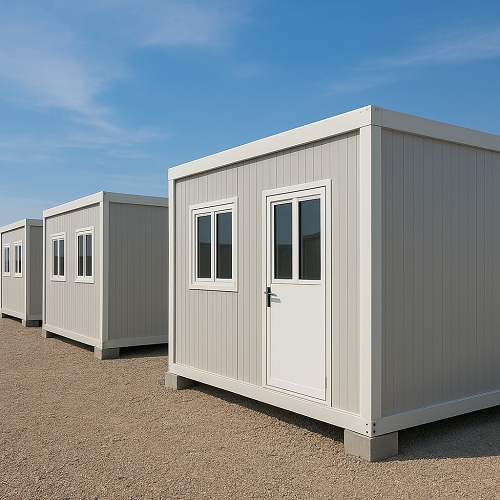In recent years, prefabricated buildings have emerged as a revolutionary solution to the growing demand for efficient, sustainable, and cost-effective construction in various sectors. Among these, education has stood out as one of the fields most profoundly impacted by this modern approach to building. Schools around the world—facing challenges of overcrowding, limited budgets, and the need for rapid expansion—are increasingly turning to prefabricated structures as a practical alternative to traditional construction.
Prefabricated buildings, often referred to as “modular buildings,” are structures whose components are manufactured off-site in a controlled factory environment and then transported to the final location for assembly. Unlike conventional buildings constructed entirely on-site, prefabricated structures benefit from precision manufacturing, reduced waste, and faster assembly times.
The process typically involves the design and production of modular sections—walls, floors, roofs, and sometimes complete rooms—that can be quickly assembled using cranes and skilled labor. These modules can be temporary or permanent and are designed to meet the same safety, durability, and comfort standards as traditional buildings.
One of the most compelling advantages of prefabrication is speed. Traditional school construction can take years from planning to completion, often disrupting ongoing education and community life. Prefabricated buildings can be designed, manufactured, and installed in a fraction of that time—sometimes in just a few months.
This rapid deployment is especially valuable in regions experiencing population growth, natural disasters, or sudden increases in student enrollment. For example, after the 2011 Christchurch earthquake in New Zealand, prefabricated classrooms were used to restore learning spaces within weeks, allowing schools to resume operations quickly and safely.
Prefabricated school buildings often cost significantly less than traditional structures. Because manufacturing takes place in a factory setting, economies of scale and standardized processes reduce material waste and labor costs. Furthermore, site preparation and building fabrication can occur simultaneously, shortening project timelines and minimizing financial disruption.
For school districts facing budget constraints, these savings make it possible to allocate funds to other critical areas—such as technology, teacher training, and curriculum enhancement—without compromising infrastructure quality.
Sustainability is another area where prefabricated buildings excel. Factories can optimize material use, recycle waste, and ensure precise energy efficiency standards. Many prefabricated school modules now feature eco-friendly materials, solar panels, energy-efficient insulation, and systems for rainwater collection.
Because components are produced in controlled environments, pollution and disturbance to the local ecosystem at the school site are minimized. This makes prefabrication an attractive option for environmentally conscious school districts and governments aiming to meet green building targets.
Gone are the days when prefabricated classrooms meant bland, box-like structures. Modern modular architecture allows for creative, aesthetic, and highly functional designs. Schools can customize layouts to include classrooms, science labs, libraries, administrative offices, gymnasiums, and even cafeterias—all built using modular techniques.
These buildings can be easily expanded or reconfigured as school needs evolve, making them a dynamic and future-proof solution. For example, if enrollment increases, additional classrooms can be added without major disruptions to existing structures.
Because prefabricated modules are built in controlled factory conditions, they often exceed the quality and safety levels of traditional construction. Every module undergoes rigorous inspections and adheres to strict building codes before being transported.
The precision of factory-based manufacturing ensures better structural integrity, improved sound insulation, and superior climate control—key factors in creating safe and conducive learning environments for students.
The UK has been a pioneer in adopting prefabricated school buildings, particularly through government-funded programs such as the “Priority School Building Program.” Dozens of modular schools have been constructed across the country, with design lifespans exceeding 60 years. Notably, schools like The Avenues School in Hull have utilized prefabricated designs to deliver high-quality, modern learning spaces at reduced costs and timelines.
In the U.S., prefabricated classrooms are widely used to address overcrowding and accommodate temporary student populations. States such as California and Texas have implemented modular buildings that meet rigorous seismic and energy efficiency standards. Some districts even use modular systems to pilot new educational models—like STEM labs and flexible learning centers—before investing in permanent expansions.
Countries like Japan, China, and Australia are also embracing prefabricated school solutions. In rapidly urbanizing areas of China, modular schools are constructed to keep pace with growing populations. Meanwhile, in rural Australia, prefabricated schools have provided vital educational access in remote areas where traditional construction is logistically challenging.
While prefabricated buildings offer many benefits, they are not without challenges. Transportation logistics can be complex, particularly in areas with limited road access. Some communities also perceive prefabricated structures as temporary or lower quality, requiring education and outreach to dispel these misconceptions.
Additionally, while customization is possible, modular designs may face limitations when it comes to highly specialized architectural requirements or integration with historic school campuses. However, advances in design software and manufacturing technology are rapidly addressing these concerns.
The future of educational infrastructure is increasingly modular. As digital design tools, automation, and sustainable materials evolve, prefabricated buildings will only become more efficient, affordable, and innovative.
Many experts predict that within the next decade, a significant portion of new school construction will rely on prefabricated methods. Hybrid models—combining traditional architecture with modular elements—will allow schools to achieve both functionality and aesthetic distinction.
The integration of smart technology—such as IoT-based climate control, renewable energy systems, and adaptable classroom layouts—will turn modular schools into models of 21st-century education.
Prefabricated buildings represent a powerful response to the challenges faced by modern education systems: the need for speed, flexibility, sustainability, and cost-effectiveness. As schools around the world continue to adapt to evolving demographic, environmental, and economic pressures, modular construction offers a blueprint for the future—one that is both practical and visionary.
